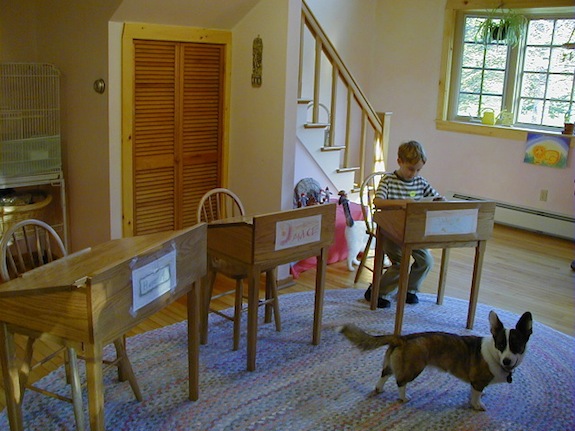You’re ready! You’ve decided to homeschool and you are thrilled at the prospect of the upcoming year . . . (sound of squealing brakes)! Wait a minute – What does a “home-school” education location look like? Let’s consider what your personal space should look like.
Many new homeschoolers like to set up a room just like a classroom and teach from there. On the other hand, I know several seasoned homeschooling families who never even had a chalk board in their homes (gasp) and their children went on to graduate from prominent colleges.
Before you create your space, especially if this is new for you, please remember that there has to be room for evolution! Not the Darwinian kind, of course, but the kind that comes from flexibility and good sense; willing to eliminate, add, move, or completely overhaul if something isn’t working.
Preparing the “education location” should begin with some heartfelt analysis of both yourself and your family. The number one thing you have to come to terms with and decide about yourself, regardless of your children, is whether you are a neat freak or not. Ask yourself to honestly answer this question before you even consider curricula. Do you need to have control? If you do that’s fine. You are going to need a place for all your school gear to be put away nicely and will probably want to organize your day differently than a person who isn’t as neat. You will most likely prefer a designated “school zone”, if not a separate classroom altogether. Just be forewarned, sometime in the future it is okay to grow out of that single area and move to different parts of your home, yard, or even local park – imagine that!
I myself fall in the middle. I can handle organized chaos for a good while, but I like to be able to make full strides when I walk. I like the pillows back on the couch when everyone is through and some days, I really want to stick to business. Understanding my own personality helped me organize my “education location” to suit me and in turn suit my children best. (Hint – rearranging furniture as often as necessary to keep the continuity fluid always helps me!)
Once we establish our own working traits we can go from there. What about our kids? Kids learn differently and find different positions comfortable. You may have a variety within your own family. There are a few kids who actually thrive at desks. I wasn’t blessed with any of those children and I don’t think I have taught any other people’s kids with this blessing. Many children love to sit on a comfy cushion on the floor, behind the couch, under the table, etc. (I have these kids) Providing safe places with clip boards or sturdy writing boards and learning tools work great for them.
In order to accommodate all of us, we incorporated school throughout all the common rooms. Our hallway is lined with four large bookcases. Science books fill half the shelves, while historical books fill the other half. The dining room has four large floor to nearly ceiling bookcases with reading books, curricular books, and shelves for learning tools and manipulatives that help my kids understand concepts easier. The living room has a large cedar chest with crates for each kid to put their current books and papers. There are two free standing cabinets with office supplies, art supplies, and more learning tools.
In the winter we snuggle up in the family room with a blazing fire and commute to the various locations when we need something and bring it back to the warmest room in the house.
Could this work for you? You probably already know yourself and your kids well enough to be thinking something like …. “This lady is nuts – I need everything in one place!!” or “What a brilliant idea! Why cram it all in one room when I can create a literal homeschool – a school throughout my entire home?!”
Let this be your starting point as you begin to decide what will be best for you and your family.
Lisa Blauvelt (with her family and three dogs, two cats, a horse, pony, donkey, two red eared turtles, a fluctuating number of tadpoles and baby fish, and various other creatures collected by her adventurous boys) puts her education degrees to work at her home in the Deep South. There she teaches not only her own children, but others who come to her home to learn. Her decade long experience in teaching children to read will soon be published as a 476 page guide for parents.
